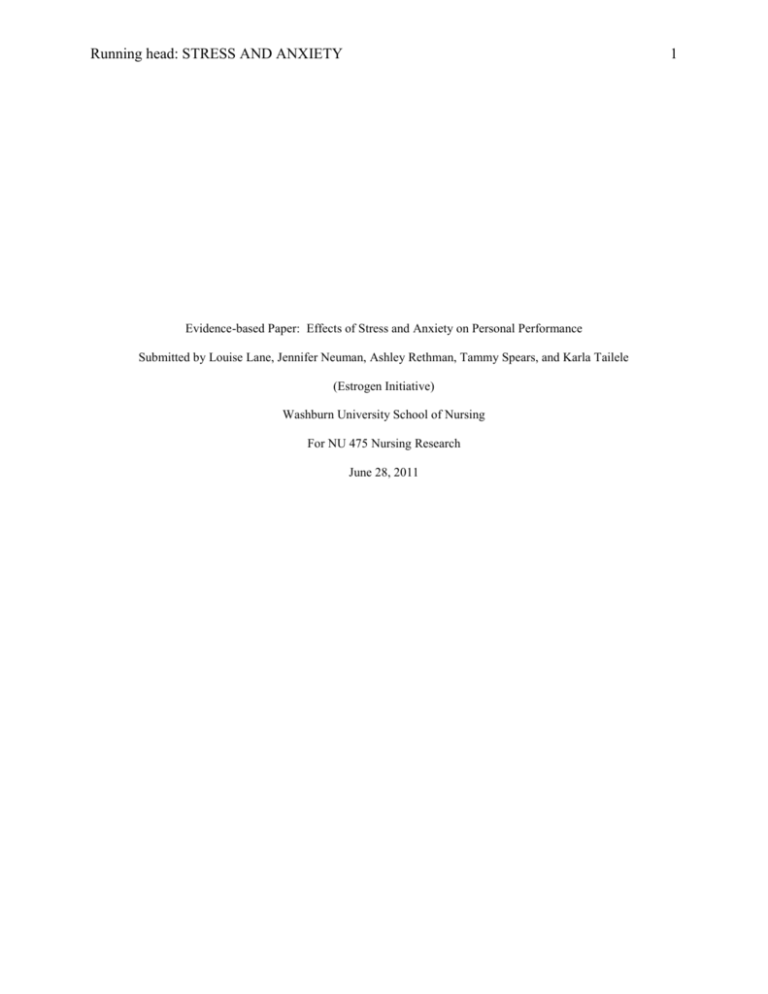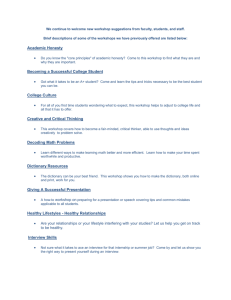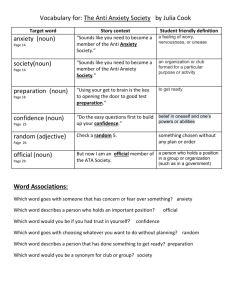EBP - estrogeninitiative
advertisement

Running head: STRESS AND ANXIETY 1 Evidence-based Paper: Effects of Stress and Anxiety on Personal Performance Submitted by Louise Lane, Jennifer Neuman, Ashley Rethman, Tammy Spears, and Karla Tailele (Estrogen Initiative) Washburn University School of Nursing For NU 475 Nursing Research June 28, 2011 Running head: STRESS AND ANXIETY 2 Effects of Stress and Anxiety on Personal Performance Introduction Anxiety is a multisystem response to a perceived threat or danger. (Gale, 2008) It can also be described as a human response to stress and involves physical, psychological, and environmental factors. (Vitasari, Wahab, Othman, & Awang, 2010) Anxiety may present itself in various forms including excessive displays of worrying, fear, or restlessness. In fact, 75% of individuals with anxiety disorders will experience it during study at university level. (Vitasari et al., 2010) “Psychological symptoms among students include feeling nervous before attending class, panicking, going blank during tests, feeling helpless while doing assignments, or lack of interest in subjects considered difficult.” (Vitasari et al., 2010) Whereas, physical symptoms may include sweaty palms, racing heartbeat, or an upset stomach. (Vitasari et al., 2010) Anxiety can also be categorized into state anxiety and trait anxiety. State anxiety is apprehension experienced at a certain period of time. Trait anxiety is a predisposition of an individual to anxious living. (Ozen, Ercan, Irgil, and Sigirli, 2010) Individuals with high levels of anxiety generally have heightened trait anxiety. (Vitasari et al., 2010) Unresolved, extended or heightened periods of anxiety can lead to negative thinking that builds towards overly emotional responses to simple issues. It can also reduce working memory, impair concentration, and reasoning. (Vitasari et al., 2010) Heightened anxiety is associated with overall lower performance and may interrupt quality of life. Additionally, “a survey conducted by Nursing Times in 1991, which included responses from 1800 nurses, indicated that stress is a major problem in nursing today. Nine out of 10 nurses in this study said they suffered from stress at work. “(Sharif & Armitage, 2004). Review of Literature The focus of anxiety among university students’ overall performance was investigated June 2010 using the Academic One File, Sage Premier, Psycinfo and the Mabee Library Science Direct: College Edition: Social and Behavior Science databases. The following keywords with the number of hits revealed in the parentheses were used: anxiety (48,141 hits), stress (35,313 hits), college students (25,382), anxiety and academic performance (1,377 hits), and stress, nursing student, academic performance and clinical (51 hits). The number of hits was reduced to journals, behavior research and therapy, and the years 2006-2011 as selection parameters. Twelve articles were reviewed and five nursing research studies relevant to the area of anxiety among university students were selected for the foundation in this review of literature. Running head: STRESS AND ANXIETY 3 Critical Appraisals Article 1 as submitted by Louise Lane This study conducted at the University of Malaysia, Pahang was designed to test the Study Anxiety Intervention to promote study anxiety resilience and positive coping skills that improve academic performance. A random quantitative study of 12 participants, 6 in the control group and 6 in the experimental group, underwent pre and post testing which utilized State Trait Anxiety Inventory and GPA as measures for reliability and validity. (Vitasari et al., 2010) The experimental group was taught biofeedback techniques in six classes, which were designed to help students reduce anxiety levels during study. The control group did not receive any instruction. It was reported in the review of research that many studies have been conducted on anxiety level, but not many have been done to design an intervention program with tools to reduce the anxiety level and then measure student’s academic performance. (Vitasari et al., 2010) The Study Anxiety Intervention included biofeedback training, which can be classified into module intervention and protocol techniques. Biofeedback assisted breathing retraining and muscle relaxation were two identified techniques taught during the classes. Heart rate and respiration assessment were also preformed during pre and post tests, in addition to the STAI and measures of GPA. (Vitasari et al., 2010) The major themes identified in the research indicated a strong correlation between the student’s anxiety level and academic performance. There was also a significant difference between the test results of the experimental and control groups, as well as, between the pre and post test results. State Trait Anxiety Inventory scores are significant on a level .024 with p≤.05 and GPA scores are significant on a level .05 with p≤.05. (Vitasari et al., 2010) The strength of the study lies with the results identified. However, this appears to be pilot study and further research was recommended to gain results from high school students. In addition, a larger number of participates would help quantify the study. Article 2 as submitted by Tammy Spears Anxiety among university students authored by Ozen, Ercan, and Sigirli in 2010 and published in the AsiaPacific Journal of Public Health. This research article dealt with measuring state and trait anxiety among university aged students in Turkey and the factors affecting outcomes. The study was a quantitative, cross-sectional, quasiexperimental design with 4,850 male and female students randomly chosen among the student population. State anxiety was defined as a subjective fear resulting from a stressful situation. Trait anxiety describes the predisposition Running head: STRESS AND ANXIETY 4 to an anxious response in what are objectively neutral situations. The study found women were more likely to experience stress, and those students who reported a need for social support also rated the most anxiety. Data was collected using Spielberger’s State-Trait Anxiety Inventory. Variables included were gender, age, department of study, year of study, living arrangements, marital status, region of longest residence, number of co-residents, family income, financial support, relationship status, parents alive, parents’ level of education, difficulty understanding lectures, adapting to university life, self-sufficiency, way of solving a problem, negative life experience, and satisfaction with department of study. This study demonstrated a clear audit trail of data collection and analysis. The logistic regression analysis of both state and trait anxiety showed risk factors were significantly associated with results being statistically significant (p<.001). The results of the study reflected similar findings of research studies conducted at several international universities. After controlling for gender and family socioeconomic status, risk factors for anxiety were discussed as well as suggested policy changes to alleviate student stress and promote better academic performance in the university setting. Article 3 as submitted by Karla Tailele Azizah, Chong, Noraini, Norzaidi, Rafidah and Salwani (2009) conducted a study to determine the relationship between stress factors, perceived stress and academic performance from Pre-Diploma students in Malaysia. The purpose was to investigate throughout the semester the affects of stress on academic performance among the students. This was a quantitative, non experimental and longitudinal design among 154 students at the UiTM Negeri Sembilan campus. To examine the relationship between the affects of stress factors, perceived stress and academic performance the researchers detailed the items on the questionnaires that were developed to measure the variables identified in the study. The variables relevant to this study were based on the students GPA and the level of perceived stress in relation to the beginning, middle, and end of the semester. In conducting this study, the authors initiated a convenience sample to administer their population. The data collections used were the PSS (perceived stress scale), Stress Factor Survey and the GPA results which were reliable in this study. The findings indicated that students experienced a moderate level of stress and there was a correlation between the levels of perceived stress at the end of semester affecting the students’ academic performance. The p value was less than 0.05 which implied that when the level of perceived stress was higher, the academic performance would be lower. Running head: STRESS AND ANXIETY 5 The ANOVA was used to test the significant differences during the different periods of the semester. Indicated in the Pearson Correlation Coefficient results shown students grade point average in the beginning at a (0.05). The statistical significant correlation between the perceived stress at the end of the semester and the students academic performance relationship value was (r =-0.201 implicating when the level of perceived stress increases the students academic performances decreases. The reliability of the study was credible with a clear purpose of the study, it was accessible, and surveys were anonymous. Although the study had a few credible resources, the study was uncontrolled, has a weak correlation and absence of evidence and on the effects of the stress factors on academic performance. Other downfalls of the study were the small campus population used and the difficulties with understanding the statistics. Overall in order to replicate the study it needed specific information to support the main variables. Article 4 as submitted by Ashley Rethman In a study done by Keogh, Bond, and Flaxman (2006), it was found that students who went through a stress management intervention group improved there test scores almost an entire letter grade after completion of the program. One hundred and sixty students were selected with a control group containing 80 students and an experimental group containing 80 students. The study used pre and post testing to determine the effects of the intervention. The tests used were the general health questionnaire, the need for achievement scale, the revised test anxiety scale, the dysfunctional attitude survey and the cognitive abilities test. An exam was completed after the intervention to determine if test scores really did improve. Due to differences in intelligence levels, it was suggested that this could be a co-variable in determining the success of the intervention and the maintained level of motivation to do well. Also, because a placebo group was not used due to ethical purposes it is hard to know if the effects of the intervention were simply due to the fact that the experimental group knew they were being treated. The 50% attrition rate also presented a weakness in this study and left the question, did intelligence keep some students there while less intelligent students tended to drop out of the intervention. P values were all in acceptable ranges. Overall this study demonstrated a clear improvement when stress management is used and opens the door to further study and research. Article 5 as submitted by Jennifer Neuman In a study done by Sharif & Armitage (2004), it was found that students who underwent psychological and educational counseling had a reduction in anxiety and an improvement in their grade point average. There was no Running head: STRESS AND ANXIETY 6 funding source that was noted and no mention of approval from any type of authority. One hundred second and fourth year nursing students were selected for the study from Shiraz University of Medical Sciences, Iran. The control group and the experimental group each had 50 participants who were randomly selected. The experimental group received counseling while the control group did not. The counseling consisted of a weekly 2-hour program over 12 weeks that focused on psychological and educational counseling. The study used a pre-test, a post-test, and a follow-up to gather information from the groups. The Hamilton Anxiety Scale was used to measure the participant’s feelings of anxiety during the three interviews. The study also used the participant’s grade point average as an indicator of performance. The studies outcomes supported the idea that anxiety affects a student’s performance in a negative way. The student’s from the experimental group showed an improved grade point average. The study used the t-test and ANOVA to analyze the information gathered from the participant’s. The ANOVA results from the pre-test showed no significance difference between the groups with F = 12.97 and P<0.001. While at the end of the semester in the follow-up it showed a reduction in anxiety with F = 6.06 and P = 0.003. The mean GPA of the control group in the pre-test was 15.5 and 15 in the experimental group. The follow-up reported a mean GPA of 15.3 for the control group and 16.4 for the experimental group. Conclusion Five articles were analyzed in the review of literature section. Each study focused on factors related to anxiety and the affects on academic performance of students. Azizah et al. (2009) found that stress affected academic performance (p<.05). Ozen, et al. (2010) reflected these findings on the affects of anxiety on academic performance (trait=40.52+/-10.51; state=43.37+/-8.32). Going a step further, Vitasari, et al. (2010) found that anxiety interventions provided a positive impact on academic performance (r=.024, p<.05). Sharif & Armitage (2004), and Keogh et al. (2006) produced similar results. Each of the studies reviewed were of a quantitative design and international in origin. The studies varied in size from 12 to 4850. Vitasari et al. (2010) was an experimental design. In contrast, Azizah et al. (2009) and Ozen et al. (2010) were non-experimental design studies. Sharif & Armitage (2004) and Keogh et al. (2006) were quasiexperimental design studies. Evaluation Intervention appears to play a significant role in the management of anxiety. Adequate academic services Running head: STRESS AND ANXIETY 7 and educational interventions may assist students in developing a positive self-image and decrease chances for emotional problems. It is recommended that universities’ consulting centers employ a sufficient number of psychologists and psychiatrists utilizing individual and group therapy modalities. Medical personnel should be trained to deal with issues related to anxiety in late adolescence to the benefit of students, universities, and the community at large. It has been observed that women do not handle stress as effectively as men. It is also notable that a greater number of nurses are women as opposed to men. If taught to manage anxiety early during study then a foundation would be laid to handle stress effectively in clinical practice. As the review of literature reflects, anxiety is an area of research that is of interest worldwide. These studies are generalizable and repeatable, and offer potential for international collaboration of nursing research. The target population of these studies primarily focused on university age participants. “University youth are generally open to change and are more sensitive to personal, interpersonal, and sociocultural differences and conflicts.” (Ozen, et al., 2010) The mechanisms learned during university years will transition well into valuable resources to be utilized in clinical practice of nurses. “Long hours of study, academic stressors, pressure of clinical practice and learning difficult materials are some of the stressors reported by nursing students.” (Sharif & Armitage, 2010) Future research areas recommended would be to extend these studies to high school students and to those beyond college age in order to determine how anxiety affects performance at work. It is also valuable to mention that stress management classes or interventions may be beneficial for nurses in practice, either to seek out on their own or be provided at their place of work. Running head: STRESS AND ANXIETY 8 References Anxiety. (n.d.) in Gale Encyclopedia of Medicine. (2008). Retrieved from http://medicaldictionary.thefreedictionary.com/anxiety Azizah, A., Chong, C. S., Noraini I., Norzaidi, D. M., Rafidah, K., & Salwani, I. M. (2009). Stress and academic performance: Empirical evidence from university students. Academy of Education Leadership Journal, 13 (1), 37-51. Keogh, E., Bond, F. W., Flasman, P. E. (2004) Improving academic performance and mental health through a stress management intervention: Outcomes and mediators of change. Behavior Research and Therapy, 44, 339-357. Doi: 10.1016/j.brat.2005.03.002 Ozen, N. S., Ercan, I., Irgil, E., Sigirli, D. (2010). Anxiety prevalence and affecting factors among university students. Asia-Pacific Journal of Public Health, 22 (1), 127-133. Doi: 10.1177/1010539509352803 Sharif, F. & Armitage, P. (2004). The effect of psychological and educational counseling in reducing anxiety in nursing students. Journal of Psychiatric and Mental Health Nursing, 11, 386-392. Doi: 10.1111/j.1365-2580.2003.00720.x Vitasari, P., Wahab, M. A., Othman, A., Awang, M. G. (2010). The use of study anxiety intervention in reducing anxiety to improve academic performance among university students. International Journal of Psychological Studies, 2 (1), 89-95. Running head: STRESS AND ANXIETY 9 Appendix A Evidence Base Paper Grid of Article Critical Appraisals Student Louise Reference source Author/ Year Purpose/Questi on/ Hypothesis Design Variables Sample & Size Internation al Journal of Psycholog ical Studies Vol 2 No 1 Vitasari, P; Wahab, M; Othman, A; Awang, M 2010 The study was designed to test the Study Anxiety Intervention to promote study anxiety resilience and Quantit ative experi mental with control group Study Anxiety Interventio n With Biofeedba ck; Anxiety; Academic Performan ce; University Students Nonprob ability purposiv e N=12 6=experi mental 6=control Data Collection Significant Findings STAI scores is significant on level .024 with P<.05 and GPA scores is significant on level .05 with p<.05 Reliability & Validity State Trait Anxiety Inventory & GPA. These were stated to be consistent with reliability & validity but stats were not shared Strengths & Weakness The results show significant difference between pre and post tests between the experiment and the control group. Running head: STRESS AND ANXIETY Karla Academy of Education al Leadershi p Journal, Vol. 13 No. 1 Azizah, Chong, Noraini, Norzaid i, Rafidah, Salwani, 2009 No hypothesis. This study was designed to investigate throughout the semester the affects of stress on academic performance among students. Quantit ative Nonexperi mental/ Longit udinal 10 The GPA and level of perceived stress in the beginning, middle, and end of the semester. Convenie nce sample N=154 Self administere d questionnai re over the semester (6 mos.) timeframe. The three sections: 1) Students profile 2) PSS (perceived stress scale) 3) Stress Factors Survey The findings indicate a moderate level of stress experienced and there was a correlation between the level of perceived stress at the end of semester and the students’ academic performance. The p value was -0.05 which implied that when the level of perceived stress was higher, the academic performance would be lower Verified results of students profile, PSS scale and Stress Factor Survey to strengthen the study. STR-study conducted last 5 years -clear purpose -accessible -survey remain anonymous WEAKNESS- weak correlation among less stress level having less affect on academic -small student population of campus -difficult understanding of statistics --time consuming Running head: STRESS AND ANXIETY Tammy AsiaPacific Journal of Public Health, Vol. 22 No. 1 Ozen, Ercan, Sigirli, 2010 Jennifer N euman Journal of Psychiatri c and Mental Health Nursing Sharif, F., Armitag e, P. (2004) This study was designed to identify risk factors for university students that affect performance and what steps school administrators can take to reduce anxiety. To find out if anxiety is reduced in nursing students will there be improvement in overall performance. 11 Quantit ative Nonexperi mental Crosssection al Difficulty understand ing lectures, status of family relationshi ps, and satisfactio n with departmen t of study. N=4,850 Random Spielberger ’s StateTrait Anxiety Inventory Point means were 40.51 +/10.51 for state anxiety and 43.37+/-8.32 for trait anxiety. P value for both trait and state was <.001. Clear audit trail of data collection and analysis. Cronbach’s alpha coefficient was .92 for trait and .85 for state. STR-Large generalizable random sample. Strong statistical results with a 95% confidence interval. IVs clearly defined. WKNS- No DV clearly defined. Too many IVs. Quasiexperi mental with pre, posttest, and follow up. A control group and focus groups were used. 12 week interventio n program (counselin g), 2nd and 4th year baccalaure ate nursing students, anxiety, GPA N = 100, control = 50 and experime ntal = 50. Pre, Post, and follow up using Hamilton Anxiety rating scale and GPA. From the pretest, the Hamilton anxiety rating scale showed that most of the students in the nursing The Hamilton Anxiety Rating Scale, GPA with tables and clear The study was only 12 weeks long which may have not been enough time for the program to take full effect. The study was done within last 5 years, it had a strong correlation between anxiety reduction and GPA increase. Running head: STRESS AND ANXIETY Ashley Rethma n Behavior Research and Therapy Vol. 44 Iss. 3 Keogh, Bond, Flaxma n (2006) Purpose: Determine whether or not a SMI is effective in improving mental health and maximizing GCSE performance and identifying the mechanisms by which such benefits occur, if indeed they do so. Hypothesis: The SMI will improve students’ mental health because it makes their cognitions more functional. An increase in motivation will mediate the relationship between our CBT SMI and GCSE performance. No question. Quantit ative quasiexperi mental with pre and post tests and a standar dized text (GCSE ). text (GCSE ). 12 Dependent : selfreport measures of stress and exam performan ce. Independe nt: Interventio n group (attended ten week trainin g group one hour a week), Control group N=80 40 in experime ntal group and 40 in control group Pre and post tests including: General Health Questionnai re using likert-type scale, Need for achievemnt scale with 42 yes/no queestions, Revised test anxiety scale using a four-point Likert rating scale, dysfunction al attitude survey with 40-item measure using a seven point Likert scale, cognative abilities test to measure intelligence . GCSE examinatio n results . High levels of dysfunctional attitudes wer significantly associated with mental ilhealth in pre and post tests. High levels of motivation during pre and post tests were significantly related GCSE scores were signigicantly different between the experimental and control group. Tables were used to clearly show data and tests used were well known. This study used well known tests most of which had good variability and reliability however, the article did not give this information completely for all tests used. There was a50% attrition rate and there was no placebo group so there could have been some level of change in exam scores just because students in the experimental group knew they should do better when taking the GCSE. Running head: STRESS AND ANXIETY 13 Appendix B Articles Reviewed 1. Vitasari, P., Wahab, M. A., Othman, A., Awang, M. G. (2010). The use of study anxiety intervention in reducing anxiety to improve academic performance among university students. International Journal of Psychological Studies, 2 (1), 89-95. 2. Ozen, N. S., Ercan, I., Irgil, E., Sigirli, D. (2010). Anxiety prevalence and affecting factors among university students. Asia-Pacific Journal of Public Health, 22 (1), 127-133. Doi: 10.1177/1010539509352803 3. Azizah, A., Chong, C. S., Noraini I., Norzaidi, D. M., Rafidah, K., & Salwani, I. M. (2009). Stress and academic performance: Empirical evidence from university students. Academy of Education Leadership Journal, 13 (1), 37-51. 4. Keogh, E., Bond, F. W., Flasman, P. E. (2004) Improving academic performance and mental health through a stress management intervention: Outcomes and mediators of change. Behavior Research and Therapy, 44, 339-357. Doi: 10.1016/j.brat.2005.03.002 5. Sharif, F. & Armitage, P. (2004). The effect of psychological and educational counseling in reducing anxiety in nursing students. Journal of Psychiatric and Mental Health Nursing, 11, 386-392. Doi: 10.1111/j.1365-2580.2003.00720.x








